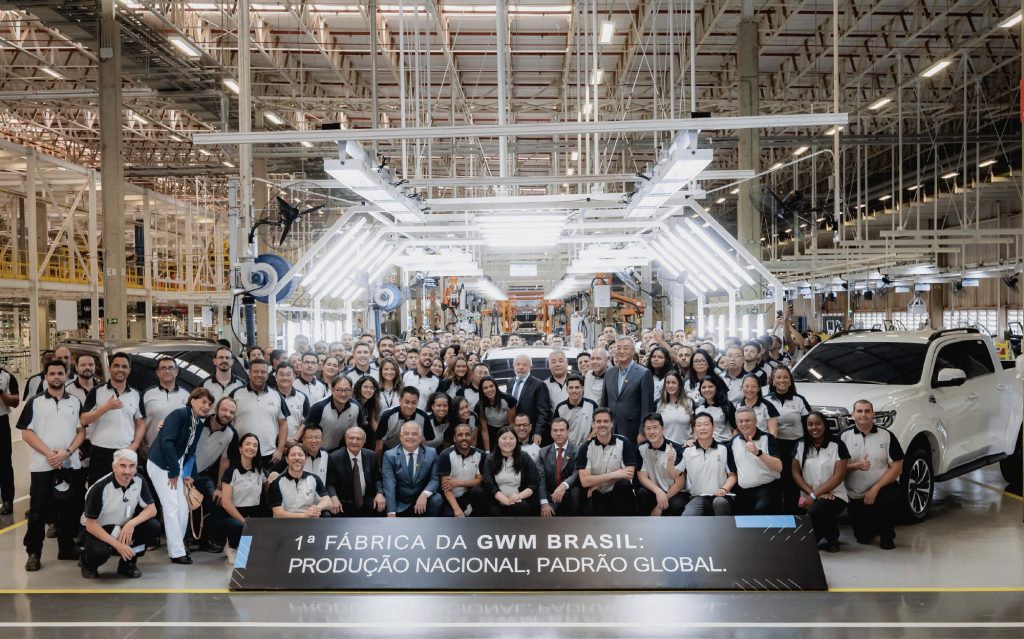The significance of the commissioning of Great Wall Motor’s factory in Brazil

The official commissioning of the Great Wall Motor factory in Brazil marks a new stage for China’s automotive industry to go global and has the following profound significance:
1. From “Selling cars” to “Building an ecosystem”
Traditional automakers’ overseas expansion mainly focuses on exporting complete vehicles. However, Great Wall Motor has achieved localized production, supply chain integration, and technology export by building a factory in Brazil. This “super fleet style public chain collective going global” model is not merely about selling products overseas, but also about driving the entire industrial chain (including component suppliers) to enter the global market together, thus building a complete industrial ecosystem.
Enhance the global influence of Chinese automobiles
The commissioning of the Brazil factory indicates that Chinese automakers are no longer content with the low-end market. Instead, they are challenging the market share of traditional automotive powers, such as those in Europe, the United States, Japan, and South Korea, through the export of high-quality products and technologies. This not only enhanced the brand image of Great Wall Motor but also set a new benchmark for “Made in China” globally.
Promoting common prosperity in industries
As a “carrier”, Great Wall Motor has driven over a hundred parts enterprises to go global together, forming a synergy effect among the upstream and downstream of the industrial chain. This model has enabled the dividends of China’s automotive industry to expand from individual enterprises to the entire supply chain, promoting the overall competitiveness of the industry.
Technological autonomy and global The Great Wall has achieved independent control of key components through self-developed core technologies (such as V8 engines, three-electric systems, etc.), avoiding being “strangled” by foreign capital. The commissioning of the Brazilian factory further validates Great Wall’s technological strength and demonstrates the competitiveness of Chinese automakers under global standards.
2. What is “super fleet type public chain collective going global”?
The “Super Fleet style public chain collective overseas expansion” is the core innovation of Great Wall Motor’s overseas expansion strategy, which can be specifically understood as:
“Super fleet” metaphor:
As a “carrier”, Great Wall Motor integrates its parts subsidiaries (such as SVOLT Energy Technology, Nuobo Auto, Jingcheng Engineering, etc.) and external suppliers to form a huge industrial cluster. These enterprises followed Great Wall Motor into overseas markets and jointly participated in global competition, similar to a fleet that fought in coordination.
The connotation of public chains:
Full industrial chain collaboration: Great Wall independently researches and develops core components (such as power batteries, chassis, cockpit systems, etc.) and exports these technologies to overseas markets. At the same time, by sharing supply chain resources with other domestic automakers, it promotes the internationalization of the entire Chinese automotive industry.
Localized production: Building a factory in Brazil not only produces complete vehicles but also introduces parts production and supply chain systems to reduce logistics costs and enhance market response speed.
Technology and brand export: Through localized production, Great Wall brings its independently developed technologies and brand influence overseas, enhancing its global competitiveness.
Meaning
This model has broken through the limitation of the traditional “single enterprise going global” and formed an industrial cluster effect with the Great Wall at its core. It not only enhanced the Great Wall’s market competitiveness but also drove the internationalization of China’s auto parts industry, achieving a win-win situation of “a hundred flowers blooming” in the industry.
3. Why did Brazil choose Great Wall Motor?
There are several key reasons behind Brazil’s choice of Great Wall Motor to build a factory:
- Technical strength and product competitiveness
Great Wall Motor has a comprehensive technological layout in multiple fields, such as new energy, hybrid, and fuel vehicles, and has formed a “hexagonal warrior” style of product competitiveness. As a country with a diversified energy structure (with both demand for fuel vehicles and potential for new energy vehicles), Brazil needs automakers like Great Wall that can provide all-power solutions. - High-quality control and global standards. The Great Wall has built its own largest collision laboratory and high-altitude simulation cabin in Asia and has invested nearly 10 billion yuan in the construction of a quality control system. This ultimate pursuit of quality has been recognized by Brazilian President Lula. After personally experiencing Great Wall Motors, Lula highly praised its quality and facilitated the introduction of the factory in Brazil.
- The localization strategy meets the needs of Brazil: The Great Wall not only exports complete vehicles but also drives employment and economic benefits through local production. As the largest automotive market in South America, Brazil has a strong demand for localized production. The Great Wall’s investment and the introduction of its industrial chain perfectly meet this demand.
- Patents and Technological Barriers The Great Wall has 50,000 patent applications (nearly 30,000 authorized), among which the proportion of new energy patents is significant. This technological accumulation has enabled the Great Wall to be competitive in the global market. What Brazil values is precisely the Great Wall’s technological autonomy and innovation capabilities.
4. Why is the technological strength of Great Wall Motor underestimated?
The technological strength of Great Wall Motor is underestimated, mainly due to the following points:
- Limitations of brand recognition:
For a long time, Chinese auto brands have been labeled as “low-priced and low-quality” in the global market. Although Great Wall has performed strongly in the domestic market (such as the Haval H6 and Tank series), it still needs time to build up its brand influence in the international market. - Misunderstandings in the selection of technical routes:
Great Wall adheres to the parallel development of oil and electricity, developing V8 engines and new energy three-electric systems, which has been regarded by some as “not focused enough”. But in fact, this all-scenario technology layout is precisely the key for the Great Wall to be able to respond flexibly in different markets. - The hidden advantages of the heavy asset model: The Great Wall has built an independent system covering the entire industrial chain by independently developing core components (such as the power batteries of SVOLT Energy Technology and the chassis of Jingcheng Engineering). This heavy-asset model requires a huge initial investment and is unlikely to show returns in the short term, thus being underestimated by the outside world. But in the long term, it provides the Great Wall with technological independence and supply chain stability.
- Accumulation of patents and R&D investment: The Great Wall has filed a total of 50,000 patent applications. In the first half of 2025, it added 2,962 new patents (including 1,118 new energy patents), and its R&D investment has exceeded 10 billion yuan for three consecutive years. This technological accumulation and investment have provided the Great Wall with a strong competitive barrier, but due to its “low-key” style, it has not been widely recognized.
5. How can Great Wall Motor be like Huawei?
The similarities between Great Wall Motor and Huawei are mainly reflected in the following aspects:
- Technological Autonomy and Patent Barriers
Huawei has strong patent barriers in fields such as chips and 5G, while Great Wall has also established a technological moat in the automotive sector with 50,000 patents (with a high proportion of new energy patents). Both have avoided being “strangled” by foreign capital through self-developed technologies. - Heavy asset model
Huawei’s self-developed chips and operating systems, while Great Wall’s self-developed V8 engines, three-electric systems, chassis, and other core components. Both have achieved full industrial chain autonomy through heavy asset investment and reduced reliance on external sources. - Industrial driving effect
Huawei drives the development of upstream and downstream enterprises through the HarmonyOS ecosystem and supply chain cooperation, while Great Wall promotes the collective progress of China’s automotive industry by driving component enterprises to go global together through the “super fleet” model. - Long-termism and Social Responsibility
Huawei attaches great importance to employee benefits and corporate culture. The Great Wall also offers free canteens, employee apartments, and other benefits, and enhances the global image of “Made in China” through high-quality overseas expansion. Both are oriented towards long-termism and pursue stable development.
6. The Success Formula of Great Wall Motor
The success of Great Wall Motor can be summarized in the following three points:
- Strict quality control systemInvest 10 billion yuan to build Asia’s largest collision laboratory and high-altitude simulation cabin to ensure the reliability of products in extreme environments. This pursuit of quality has won the trust of the global market.
- Full-scenario technology layoutIt covers various power forms such as gasoline, diesel, hybrid, pure electric, and hydrogen energy, meeting the demands of different countries and markets. The Great Wall has achieved comprehensive technological coverage through its product strategy of “robust four-wheel drive performance and economical two-wheel drive energy”.
- Global Standards and Technology Verification Wall has invested a research and development team of 23,000 people, with over 10 billion yuan in R&D investment for three consecutive years. It has established a full life cycle technology verification system to ensure the safety and reliability of its products. This responsible attitude towards users is the key to the Great Wall becoming a “new business card of Chinese automobiles”.
7. Implications for China’s Automotive Industry
The commissioning of Great Wall Motor’s Brazilian factory and its “super fleet” model offer the following inspirations for China’s automotive industry:
- From single overseas expansion to cluster overseas expansion
Chinese automakers should shift from merely exporting complete vehicles to going global across the entire industrial chain, driving the common development of component enterprises and creating a cluster effect of industries. - Technological autonomy is at the core
Only by mastering core technologies (such as engines, three-electricity systems, etc.) can one avoid being held back in the global market and enhance bargaining power. - High-quality overseas expansion is the key
Through strict quality control, full-scenario technical layout, and global standard verification, Chinese automakers can change the stereotype of “low price and low quality” and establish a high-end brand image. - Industrial Synergy and Common Prosperity
Leading enterprises should play the role of “aircraft carriers”, driving small and medium-sized component enterprises to go global together and achieve overall industrial upgrading.
8. Supplementary analysis of the Brazilian factory
- Economic and social impacts
The Great Wall Brazil factory not only creates job opportunities but also reduces tariffs and logistics costs through localized production, enhancing the competitiveness of its products. Meanwhile, the commissioning of the factory will drive the technological upgrading of Brazil’s automotive industry and promote local economic development. - Market potential
As the largest automotive market in South America, Brazil has huge consumption potential. Through localized production, Great Wall can respond more quickly to market demands and launch models (such as hybrid and fuel vehicles) that suit the preferences of local consumers. - The starting point of global layout:
The factory in Brazil is an important step in the Great Wall’s globalization strategy. In the future, the Great Wall may take Brazil as a bridgehead to further expand its market in South America and even globally.
Conclusion
The commissioning of the Great Wall Motor factory in Brazil marks the transformation of China’s automotive industry from “product export” to “industrial export”. Through the “super fleet style public chain collective going global” model, Great Wall has not only enhanced its brand influence but also driven the globalization of China’s automotive industry chain, achieving common prosperity in the industry. Brazil chose Great Wall Motor because of its strong technical strength, strict quality control system, and full-scenario technical layout. The Great Wall has broken the foreign monopoly by independently developing core technologies such as the V8 engine and the three-electricity system, demonstrating a spirit of technological autonomy similar to that of Huawei. This model provides a new model for the high-quality overseas expansion of China’s automotive industry and also establishes a new business card for “Made in China” in the global market.
